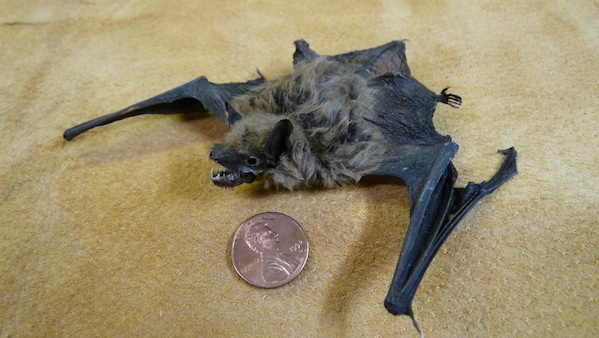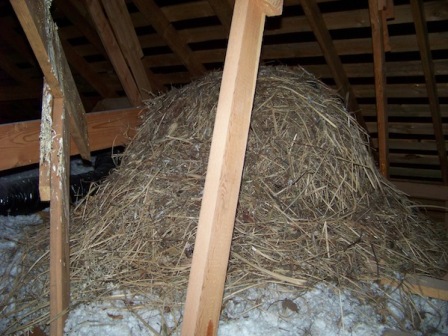Mastering Roof Inspections: Pests
by Kenton Shepard and Nick Gromicko, CMI®
The purpose of the series “Mastering Roof Inspections” is to teach home inspectors, as well as insurance and roofing professionals, how to recognize proper and improper conditions while inspecting steep-slope, residential roofs. This series covers roof framing, roofing materials, the attic, and the conditions that affect the roofing materials and components, including wind and hail.
Here are a few of the hazards you should be aware of when you perform inspections.
Insects
The insects of most concern are stinging insects, since it hurts to get stung, and some people are allergic to insect venom. Bees, hornets and wasps are the insects you’re most likely to find on roofs.

This is a wasps' nest. You may find a beehive or wasps' nest, or you may find the insects themselves. Insects can live in the attic, entering and leaving through ventilators or other roof penetrations. They may also live in or just beneath the roofing material.
It's good to know the area in which you work and what you’re likely to find. The types of stinging insects vary widely in terms of their aggression. Some may attack immediately as a swarm, and others may attack only under extreme provocation. Finding yourself in the middle of a swarm of angry, stinging insects doesn’t leave you a lot of options. You need to get off the roof. Trying to get off a high, steep roof in a hurry can get you killed. That’s one more good reason to tie off your ladder. If you attempt to mount your ladder and you knock it off the roof, or it starts to slide as you’re stepping onto it, your options will be severely limited.
Raccoons
Raccoons are common in many parts of North America. Attics are good places for raccoons to raise their young -- at least, from the raccoon’s point of view.

Their method of entry is to get onto the roof, and then try to chew, claw and rip their way into the attic through any part of the home that looks like it might be a weak spot. This includes loose or decayed siding or roof sheathing.
Ice dams sometimes cause sheathing near the roof edge to decay, and both raccoons and squirrels will tear at these areas.
In addition to encephalitis, raccoons can carry rabies and distemper, so you don’t want to be bitten.

This is an example of the kind of space that raccoons love to raise young in. The mother tore her way in through the louvers, which were boarded over by the inspector after flushing the mother and three babies out using mothballs. The inspector tossed in a handful of mothballs in the early evening, and the mother moved the young out overnight.
Bats
Bats also carry rabies. Rabies shots are painful and expensive, and you can’t always tell that you’ve been bitten. Untreated rabies is fatal to humans.

If you see bats in the attic, something handy such as a tennis racket is not going to provide adequate protection, so you need to leave the attic and notify the occupants. This mouse-eared bat is dried and was found in a dry sump pump pit. A bat like this can fit through a crack not much bigger than a quarter-inch.

Courtesy of Mike Roberson
This photo shows a column of bats roosting just inside a gable vent.

Courtesy of Mike Roberson
*Constantine, Denny G. (April 1962). "Rabies transmission by nonbite route" (PDF). Public Health Reports (Public Health Service) 77 (4): 287–289. PMID 13880956. PMC 1914752. http://www.pubmedcentral.nih.gov/picrender.fcgi?artid=1914752&blobtype=pdf.

This pack rat nest was discovered in a crawlspace. You may also see them in attics. Nests are typically about 3 feet across.
Squirrels

This is a photo of a squirrel’s nest. You should mention in your report any nests you discover, and recommend that the attic is confirmed to be free of animals before any access holes are sealed off.

Here’s a typical squirrel entry hole at the base of a valley where the sheathing has likely been softened by decay.
Birds

Courtesy of Buck Hartley
A heavy accumulation of bird droppings or a pile of nesting material is a good clue that birds have been using the attic for a roost. In this case, the birds were starlings. Birds can carry histoplasmosis, a fungal infection that affects the human respiratory system.
**************************************************
Learn how to master a roof inspection from beginning to end by reading the entire InterNACHI series: Mastering Roof Inspections.
Take InterNACHI’s free, online Roofing Inspection Course
Mastering Roof Inspections
Roofing Underlayment Types
Inspecting Underlayment on Roofs
Fall-Arrest Systems
Roofing (consumer-targeted)
More inspection articles like this

